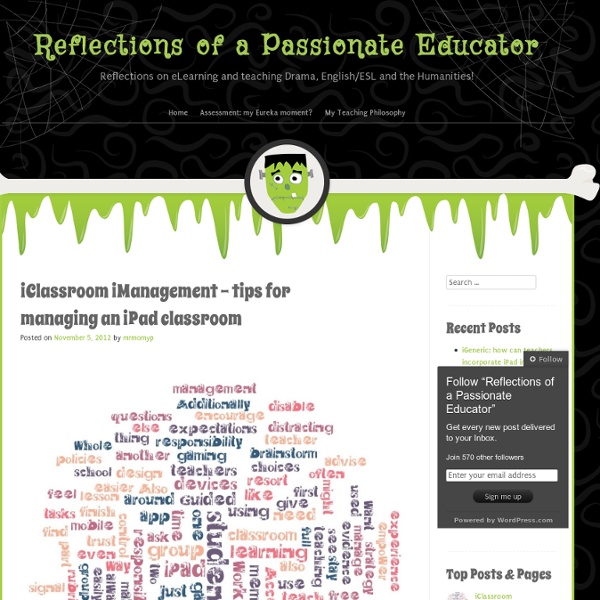iClassroom iManagement – tips for managing an iPad classroom

iLearned vs. iLearning: Differentiated portfolio assessment with the iPad?
Differentiated learning is at the heart of my teaching philosophy. I believe teachers need to make a conscious effort to embrace all learning styles in their instruction, and to embed these learning styles in their assessments. I also believe the iPad makes doing so much easier, as it has for me. The iPad, and its enormous range of educational apps, offer multiple ways of teaching. Differentiation needs to be equally embedded in assessment as it is in teaching. I am a big fan of portfolio assessment. Planning : a huge variety of brainstorming and mind-mapping apps can be found in the App Store. While I have described my portfolio assessment practices in the drama classroom, along with my attempts to differentiate to cater for all learning styles, I believe such practices can be replicated in any other subject area. Update 25/05/2013 I delivered a presentation at the ICTEV 2013 conference about this, you can find the PowerPoint I used here. Like this: Like Loading...
iOrganized: How a teacher can use the iPad to stay organized?
I bought my iPad about eighteen months ago. I have said it before, and will say it again: it has changed my life! As an eLearning leader, one of the most common complaints I receive from staff is that “it is really hard to stay organized with the iPad! Everything is all over the place!” 1- Curriculum-design (unit-planning): I use Pages to help me stay on top of curriculum design. 2- Lesson-planning: I use Evernote to plan my lessons. 3- Documentation: I use Evernote to document evidence from my lessons. 4- Reflection: I add a very short reflection to my Evernote lesson-planning after every lesson. 5- Attendance and Assessment records: I use Numbers to keep my attendance and assessment records. 6- File-sharing and printing: many teachers initially complained that the iPad does not have a USB port. 7- Marking and grading: when the students send me work, I often ask to receive it as a PDF (most apps allow exporting as PDFs). Like this: Like Loading...
iCollaborate: making the most of collaborative learning in an iPad classroom?
I started my teaching career at an international school in Egypt. This school had a very structured curriculum and used standardized testing very often. I learned a lot from working there, I have to admit. But one thing I found rather displeasing about the curriculum was that it only encouraged and facilitated individual learning. There weren’t many opportunities for group work or collaborative learning. When I moved to Australia, I took up a job at an IB school in Melbourne. I believe the benefits of collaborative learning far outweigh the challenges (I recommend reading this article to find out more about the benefits of collaborative learning and how to make the most of it). This it what I do in my classroom to make the most of a collaborative learning process that incorporates the iPad (i.e. to minimize distractions, maximize group engagement in the collaborative process, and to manage the classroom more effectively): How do you make the most of group work in your iPad classrooms?
iCreate: How the iPad facilitates content-creation in the classroom?
Andrew Douch wrote “the iPad is a swiss army knife of content-creation tools”. I read that sentence in his blogpost ‘How an iPad is a More Powerful Content-Creation Device Than a Laptop‘ and realised that he managed to say what I have been trying so hard to say for months, but just couldn’t find the words or gather the courage. I constantly come across teachers who argue that the iPad is very limiting and restricting, and that a laptop is far more superior. I personally disagree, but found it hard to argue my case. Andrew Douch wrote that ‘if professional production quality is your imperative, then the iPad is not your best tool’ and that it may be best to find a more ‘technologically capable’ device. ‘But producing comparable creative content on an iPad is relatively quick, simple, yields impressive results with minimal fuss, and the learning curve is … well, there almost isn’t one! And that is the truth, ladies and gentlemen. Like this: Like Loading...
Related:
Related:



